Intel's Pentium 4 670: Just Another Speed Bump
by Derek Wilson on May 26, 2005 9:00 AM EST- Posted in
- CPUs
Workstation Applications
SPECviewperf 8
SPECviewperf is a collection of application traces taken from some of the most popular professional applications, and compiled together in a single set of benchmarks used to estimate performance in the various applications in which the benchmark is used to model. With version 8, SPEC has significantly improved the quality of the benchmark, making it even more of a real world indicator of performance.We have included SPEC's official description of each one of the 8 tests in the suite.
3dsmax Viewset (3dsmax-03)
"The 3dsmax-03 viewset was created from traces of the graphics workload generated by 3ds max 3.1. To insure a common comparison point, the OpenGL plug-in driver from Discreet was used during tracing.
The models for this viewset came from the SPECapc 3ds max 3.1 benchmark. Each model was measured with two different lighting models to reflect a range of potential 3ds max users. The high-complexity model uses five to seven positional lights as defined by the SPECapc benchmark and reflects how a high-end user would work with 3ds max. The medium-complexity lighting models uses two positional lights, a more common lighting environment.
The viewset is based on a trace of the running application and includes all the state changes found during normal 3ds max operation. Immediate-mode OpenGL calls are used to transfer data to the graphics subsystem."
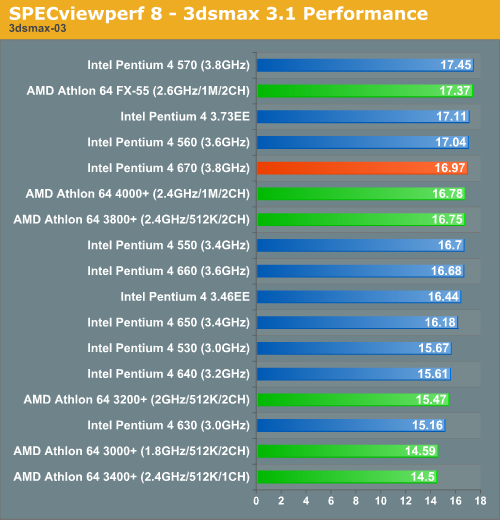
CATIA Viewset (catia-01)
"The catia-01 viewset was created from traces of the graphics workload generated by the CATIATM V5R12 application from Dassault Systems.
Three models are measured using various modes in CATIA. Phil Harris of LionHeart Solutions, developer of CATBench2003, supplied SPEC/GPC with the models used to measure the CATIA application. The models are courtesy of CATBench2003 and CATIA Community.
The car model contains more than two million points. SPECviewperf replicates the geometry represented by the smaller engine block and submarine models to increase complexity and decrease frame rates. After replication, these models contain 1.2 million vertices (engine block) and 1.8 million vertices (submarine).
State changes as made by the application are included throughout the rendering of the model, including matrix, material, light and line-stipple changes. All state changes are derived from a trace of the running application. The state changes put considerably more stress on graphics subsystems than the simple geometry dumps found in older SPECviewperf viewsets.
Mirroring the application, draw arrays are used for some tests and immediate mode used for others."
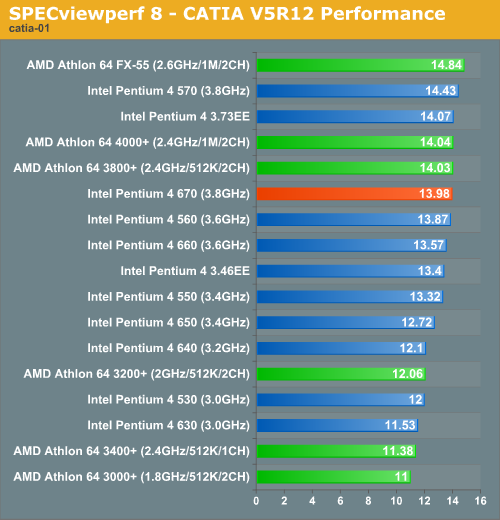
Lightscape Viewset (light-07)
"The light-07 viewset was created from traces of the graphics workload generated by the Lightscape Visualization System from Discreet Logic. Lightscape combines proprietary radiosity algorithms with a physically based lighting interface.
The most significant feature of Lightscape is its ability to accurately simulate global illumination effects by precalculating the diffuse energy distribution in an environment and storing the lighting distribution as part of the 3D model. The resulting lighting "mesh" can then be rapidly displayed."
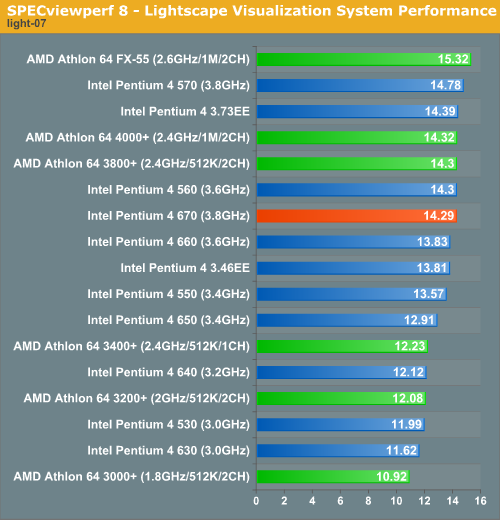
Maya Viewset (maya-01)
"The maya-01 viewset was created from traces of the graphics workload generated by the Maya V5 application from Alias.
The models used in the tests were contributed by artists at NVIDIA. Various modes in the Maya application are measured.
State changes as made by the application are included throughout the rendering of the model, including matrix, material, light and line-stipple changes. All state changes are derived from a trace of the running application. The state changes put considerably more stress on graphics subsystems than the simple geometry dumps found in older viewsets.
As in the Maya V5 application, array element is used to transfer data through the OpenGL API."

Pro/ENGINEER (proe-03)
"The proe-03 viewset was created from traces of the graphics workload generated by the Pro/ENGINEER 2001TM application from PTC.
Two models and three rendering modes are measured during the test. PTC contributed the models to SPEC for use in measurement of the Pro/ENGINEER application. The first of the models, the PTC World Car, represents a large-model workload composed of 3.9 to 5.9 million vertices. This model is measured in shaded, hidden-line removal, and wireframe modes. The wireframe workloads are measured both in normal and antialiased mode. The second model is a copier. It is a medium-sized model made up of 485,000 to 1.6 million vertices. Shaded and hidden-line-removal modes were measured for this model.
This viewset includes state changes as made by the application throughout the rendering of the model, including matrix, material, light and line-stipple changes. The PTC World Car shaded frames include more than 100MB of state and vertex information per frame. All state changes are derived from a trace of the running application. The state changes put considerably more stress on graphics subsystems than the simple geometry dumps found in older viewsets.
Mirroring the application, draw arrays are used for the shaded tests and immediate mode is used for the wireframe. The gradient background used by the Pro/E application is also included to better model the application workload."
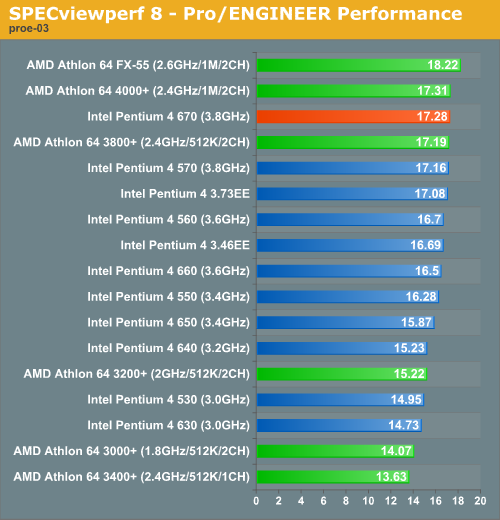
SolidWorks Viewset (sw-01)
"The sw-01 viewset was created from traces of the graphics workload generated by the Solidworks 2004 application from Dassault Systemes.
The model and workloads used were contributed by Solidworks as part of the SPECapc for SolidWorks 2004 benchmark.
State changes as made by the application are included throughout the rendering of the model, including matrix, material, light and line-stipple changes. All state changes are derived from a trace of the running application. The state changes put considerably more stress on graphics subsystems than the simple geometry dumps found in older viewsets.
Mirroring the application, draw arrays are used for some tests and immediate mode used for others."
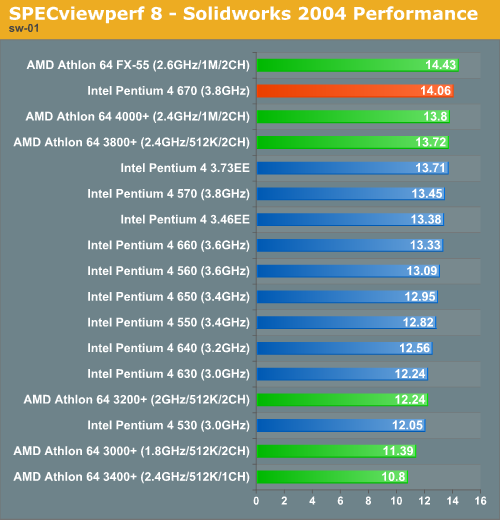
Unigraphics (ugs-04)
"The ugs-04 viewset was created from traces of the graphics workload generated by Unigraphics V17.
The engine model used was taken from the SPECapc for Unigraphics V17 application benchmark. Three rendering modes are measured -- shaded, shaded with transparency, and wireframe. The wireframe workloads are measured both in normal and anti-alised mode. All tests are repeated twice, rotating once in the center of the screen and then moving about the frame to measure clipping performance.
The viewset is based on a trace of the running application and includes all the state changes found during normal Unigraphics operation. As with the application, OpenGL display lists are used to transfer data to the graphics subsystem. Thousands of display lists of varying sizes go into generating each frame of the model.
To increase model size and complexity, SPECviewperf 8.0 replicates the model two times more than the previous ugs-03 test."
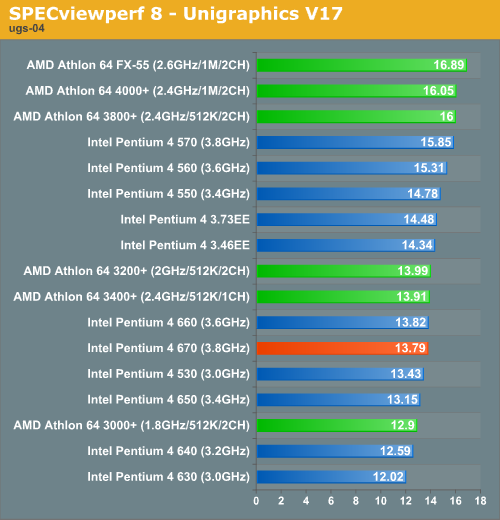










33 Comments
View All Comments
JustAnAverageGuy - Thursday, May 26, 2005 - link
"And I suppose if AMD released a venice core clocked @ 2.6 Ghz, you all would not be calling it "just a speed bump". Rather, it would be considered a huge deal, and you all WOULD care."2.4 --> 2.6 != 3.6 --> 3.8 (% speed increase)
Also consider the fact that 200 "A64 Mhz" aren't equal to 200 "P4 MHz"
AkumaX - Thursday, May 26, 2005 - link
#11,They're trying to distinguish between S754 and S939 (single channel vs dual channel memory)
is my S754 Newcastle @ 10 x 240 = 2400mhz really that slow? :P
Admiral Ackbar - Thursday, May 26, 2005 - link
Sorry but I have missed something, what does the 1CH versus 2CH mean on the Athlons?mjz - Thursday, May 26, 2005 - link
5 - Posted on May 26, 2005 at 2:42 PM by flatblastard ReplyAnd I suppose if AMD released a venice core clocked @ 2.6 Ghz, you all would not be calling it "just a speed bump". Rather, it would be considered a huge deal, and you all WOULD care.
----
don't forget, a 200 MHz increase with AMD cpus is like a 300+ MHz increase for intel
ViRGE - Thursday, May 26, 2005 - link
#3 is right, there are some major discrepancies between the actual results and what was predicted. Take a look at the WinZip and Nero numbers; for Winzip, the 650->660->670 comes in at 430->411->349 respectively(or a difference of 29->62), and Nero shows 560->550->456(for a difference of 10->94!). Something has to have been changed her, be it a hard drive or drivers; the 670 scores do no correlate with the other 6xx scores at all.mlittl3 - Thursday, May 26, 2005 - link
#5,This article would be worded totally different if the 670 performed consistently better than the 570 from benchmark to benchmark. Instead it wins some and loses some.
As #4 says, even the 3.43 gallatin EE beats the 3.73 prescott EE in a lot of the benchmarks.
Intel is unreliable when it comes to new processors until the Pentium M is revamped in the form of Yonah and of course as #6 stated Conroe (don't forget Cedar Mill).
AMD was bashed left and right when they went from Palamino to Thoroughbred A to Thoroughbred B to Barton. There were very little performance improvements between these chips and they kept getting hotter and hotter. Review sites were constantly saying that the Athlon XP had gone as far as it can go and ran out of steam around the Athlon XP 2500+.
Therefore, AMD came out with the Athlon 64 and fixed all the problems. Each release of a new chip usually has brought speed improvements and decreased power usage.
Now its Intel's turn. The Pentium 4 architecture has run out of steam. Each new processor brings nothing new to the table and in some cases hurts performance. The Pentium 4 was at the peak with the Northwood core, therefore, logically, reviews sites and comment boards are bashing Intel.
Once Intel releases the next gen processors and AMD's Athlon 64 runs out of steam, the review sites and comment boards will change directions once again as always.
Please read this article at xbitlabs for further info on the history of the Pentium 4 and why Intel is no longer going to support it soon.
http://www.xbitlabs.com/articles/cpu/display/netbu...
yacoub - Thursday, May 26, 2005 - link
"In order to continue getting the same performance boost form part to part"form/from
=)
BitByBit - Thursday, May 26, 2005 - link
The 6xx line is to the Athlon 64 as Barton was to the P4C - just a fill-in to avoid embarrassing benchmark defeats until Intel's replacement appears; Conroe.flatblastard - Thursday, May 26, 2005 - link
And I suppose if AMD released a venice core clocked @ 2.6 Ghz, you all would not be calling it "just a speed bump". Rather, it would be considered a huge deal, and you all WOULD care.plewis00 - Thursday, May 26, 2005 - link
It does perform well in somethings but the increased latency is bad - the last benchmark, SPECviewperf 8 - Unigraphics V17, where the 5xx series pretty much consistently beat the 6xx, that is awful when it costs so much more, if you pay more for something you'd expect it to perform better. Similar thing with the 3.4XE (Gallatin-based) and 3.73XE (Prescott-based) in the past. Like many others I'm jumping ship on Intel now unless I can easily get a hold of a Pentium M SFF with SATA support (I'd rather not get the 915 cos of PCIe and DDR2), let's face it, Pentium M is pretty much Intel's only strong performer these days...